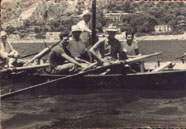|  From
a natural point of view, the Strait of Messina
represents a very particular and unique
environment, where Thyrrenian and Ionian
seas meet and, due to very complex hydrographic
phenomena, create characteristic alternations
of constant, and often strong, currents
determining the presence of several species
and behaviours typical of some hicthyc species.
Consequently all through the centuries the
unique fishing methods have been developped,
and today they are still in use successfully.
Among them there is no doubt that the traditional
sword-fish capture deserves a special consideration. From
a natural point of view, the Strait of Messina
represents a very particular and unique
environment, where Thyrrenian and Ionian
seas meet and, due to very complex hydrographic
phenomena, create characteristic alternations
of constant, and often strong, currents
determining the presence of several species
and behaviours typical of some hicthyc species.
Consequently all through the centuries the
unique fishing methods have been developped,
and today they are still in use successfully.
Among them there is no doubt that the traditional
sword-fish capture deserves a special consideration.
The
sword-fish (Xiphias gladius) capture in
the strait of Messina has been practiced
for centuries with the same old system,
and only a few variations which are not
related to the fishing method but the modernization
of the fishing boats used. In fact, at the
beginning, fishing was carried out using
small but very fast rowing boats called
luntri
which supported a big boat provided
with a main-mast about 10 metres high called
fulua . Such a boat was anchored at about
400 metres from the coast. When a sailor
watched a sword-fish from a main-must, he
showed it to a member of the crew (patrùni),
took a long boom provided with a hook and
threw it with great skill hitting the fish
; that started a furious fight. All through
the years, the system has remained the same,
but the fishing boats have changed. Today
they are 15 metres long, and are eqiupped
with powerful engins, a main-mast (n'tinna)
25/30 metres high and a gangway reaching
a lenght of 60 metres in the biggest boats.
The feluca controls are on the main-mast,
the crew is usually composed of 6 men, 3
of whom are watchers. As soon as they identify
the sword-fish, the boat starts approaching
it
until the hooker hits the prey.
|